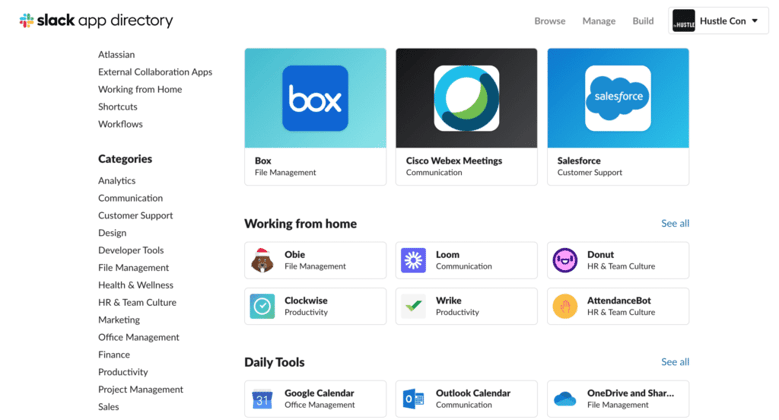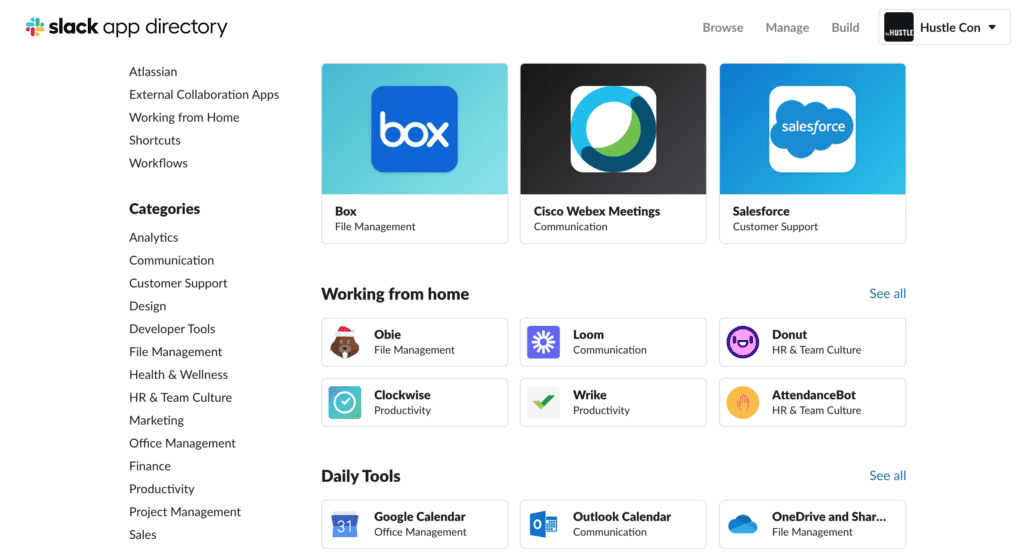nlopchantamang.com
Slack’s App Directory, the Perfect Home for New WFH SaaS
Aja Frost @ajavuu

Source: Slack
The Signal: Back in 2015, Slack teamed up with their buddies over at Accel, Index, and a16z (just to name a few), and rolled out a $80m fund, “to support teams building products on top of Slack that enable simpler, more pleasant, and more productive workplaces.”
With about 7 investments each year in its first 4 years of existence, a pandemic-fueled remote shift has the Slack Fund participating in 15 investments this year alone (not done yet), totaling $296.4m to companies building on top of Slack.
Enter Slack’s app directory. Launched in 2015 and standing at 2,411 apps strong, a 34% increase in the last 12 months alone, it shows there’s strong demand for applications that can address the pain points of teams transitioning from a physical office to a virtual workspace.
Slack’s CEO, Stewart Butterfield, has said companies have developed 500k+ apps internally to help with their workflows, pointing to massive white space between the availability of apps on the directory and apps that solve problems for hundreds of thousands of companies.
The workforce shift that has rocked the world will turn the unified communications market into a $167.1B market by 2025 (nothing to sneeze at, but hockey-stick growth incoming). Ninety-nine percent of remote workers want to continue telecommuting at least part of the time in the future, so the trend isn’t going away.
The Big Picture: Slack is just one example of a platform with an exploding app marketplace. Zoom, Asana, Monday, and Shopify are only a few others.
The key to capitalizing in this space is to go niche. We recently interviewed Harley Finkelstein, the president of Shopify. When we asked him which Shopify Apps don’t exist that should exist, he told us, “The neat part about the ecosystem is that because we have more than a million stores, we have so many different verticals.
“There isn’t one particular thing that everyone needs… But every single business has particular needs that are not like anyone else’s… That is where the opportunity exists for someone to come in and build for particular [verticals].”
Below we outline opportunities for new remote work apps built for Slack and its next big competitor, a highly controversial topic on Twitter.
Opportunities: This continued shift has led to companies having to develop or purchase solutions to help bring the in-office experience into their Slack workspaces. That’s where we identified a few opportunities for building businesses.

Company Culture: Culture in the remote world has dropped off a cliff. As cool as you might be, no one wants to attend your mandatory Zoom Happy Hour. However, casual conversations and gossip accounted for 52 minutes of every person’s workday, according to a study, and that gossip (good or bad) led to more team cohesion.
Donut is a Slack app built on this premise, which connects team members around the virtual watercooler.
There’s a clear opportunity to build on this idea: There was a ~2,500% increase in interest online for virtual team-building activities during quarantine, and there isn’t a clear market leader… yet. An app centered on building community inside of Slack workspaces is a great way to get people to learn about each other.
Stress Management: Job and work stress costs employers over $300B annually, and that’s why businesses are spending 9 figures a year to address the problem. A Deloitte study pointed out an ROI of ~$1.24 per dollar spent on mental health and wellness programs for employees.
Companies are looking for better ways to provide these programs and get their employees to actually use them.
What better channel of adoption than Slack? Provide guided, daily meditations straight to Slack DMs or do weekly check-ins to get a pulse on how team members are feeling, all with an app.
Analytics: Seventy percent of companies say they want and need more people analytics, largely because quantifying productivity in an office setting is difficult.
With communication, project management, and online statuses now quantitative thanks to Slack’s treasure trove of data and integrations, there’s an opportunity to identify workload and productivity trends among the workspace.
This gives businesses the opportunity to make more informed decisions and recognize employees for their achievements (something employees say is the No. 1 thing that leads to better work output).
Seeing who communicated the most, who spent the most time active on Slack, and where work happened gives you a data-focused, bird’s-eye view of what’s happening across the company.
Customization: While Slack’s app directory stands at ~2.4k applications, there are 500k other workspaces that have failed to find what they’re looking for in the directory and have developed custom solutions: “95% of Slack app users say apps in Slack make the parent software more valuable.”
As a few agencies focused solely on this issue already have (see Slack’s Partners page), there’s a growing opportunity to jump into leveraging developmental knowledge or Slack’s new built-in workflow builder to build custom solutions to the needs of Slack customers and their workspaces through an agency-style approach.
Leave a Comment